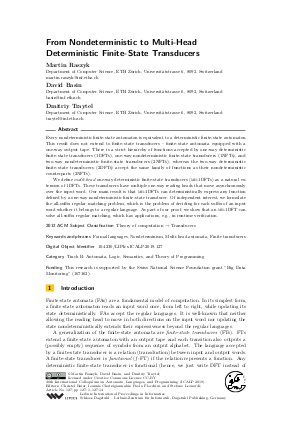From Nondeterministic to Multi-Head Deterministic Finite-State Transducers (Track B: Automata, Logic, Semantics, and Theory of Programming)
Authors Martin Raszyk, David Basin, Dmitriy Traytel
-
Part of:
Volume:
46th International Colloquium on Automata, Languages, and Programming (ICALP 2019)
Part of: Series: Leibniz International Proceedings in Informatics (LIPIcs)
Part of: Conference: International Colloquium on Automata, Languages, and Programming (ICALP) - License:
 Creative Commons Attribution 3.0 Unported license
Creative Commons Attribution 3.0 Unported license
- Publication Date: 2019-07-04
File

PDF
LIPIcs.ICALP.2019.127.pdf
- Filesize: 0.53 MB
- 14 pages
Document Identifiers
Subject Classification
ACM Subject Classification
- Theory of computation → Transducers
Keywords
- Formal languages
- Nondeterminism
- Multi-head automata
- Finite transducers
Metrics
- Access Statistics
-
Total Accesses (updated on a weekly basis)
0Document
0Metadata
Abstract
Every nondeterministic finite-state automaton is equivalent to a deterministic finite-state automaton. This result does not extend to finite-state transducers - finite-state automata equipped with a one-way output tape. There is a strict hierarchy of functions accepted by one-way deterministic finite-state transducers (1DFTs), one-way nondeterministic finite-state transducers (1NFTs), and two-way nondeterministic finite-state transducers (2NFTs), whereas the two-way deterministic finite-state transducers (2DFTs) accept the same family of functions as their nondeterministic counterparts (2NFTs). We define multi-head one-way deterministic finite-state transducers (mh-1DFTs) as a natural extension of 1DFTs. These transducers have multiple one-way reading heads that move asynchronously over the input word. Our main result is that mh-1DFTs can deterministically express any function defined by a one-way nondeterministic finite-state transducer. Of independent interest, we formulate the all-suffix regular matching problem, which is the problem of deciding for each suffix of an input word whether it belongs to a regular language. As part of our proof, we show that an mh-1DFT can solve all-suffix regular matching, which has applications, e.g., in runtime verification.
Cite As Get BibTex
Martin Raszyk, David Basin, and Dmitriy Traytel. From Nondeterministic to Multi-Head Deterministic Finite-State Transducers (Track B: Automata, Logic, Semantics, and Theory of Programming). In 46th International Colloquium on Automata, Languages, and Programming (ICALP 2019). Leibniz International Proceedings in Informatics (LIPIcs), Volume 132, pp. 127:1-127:14, Schloss Dagstuhl – Leibniz-Zentrum für Informatik (2019)
https://doi.org/10.4230/LIPIcs.ICALP.2019.127
BibTex
@InProceedings{raszyk_et_al:LIPIcs.ICALP.2019.127,
author = {Raszyk, Martin and Basin, David and Traytel, Dmitriy},
title = {{From Nondeterministic to Multi-Head Deterministic Finite-State Transducers}},
booktitle = {46th International Colloquium on Automata, Languages, and Programming (ICALP 2019)},
pages = {127:1--127:14},
series = {Leibniz International Proceedings in Informatics (LIPIcs)},
ISBN = {978-3-95977-109-2},
ISSN = {1868-8969},
year = {2019},
volume = {132},
editor = {Baier, Christel and Chatzigiannakis, Ioannis and Flocchini, Paola and Leonardi, Stefano},
publisher = {Schloss Dagstuhl -- Leibniz-Zentrum f{\"u}r Informatik},
address = {Dagstuhl, Germany},
URL = {https://drops.dagstuhl.de/entities/document/10.4230/LIPIcs.ICALP.2019.127},
URN = {urn:nbn:de:0030-drops-107037},
doi = {10.4230/LIPIcs.ICALP.2019.127},
annote = {Keywords: Formal languages, Nondeterminism, Multi-head automata, Finite transducers}
}
Author Details
Funding
This research is supported by the Swiss National Science Foundation grant "Big Data Monitoring" (167162).
References
-
Eugene Asarin, Paul Caspi, and Oded Maler. Timed regular expressions. J. ACM, 49(2):172-206, 2002.

-
David Basin, Bhargav Bhatt, Srđan Krstić, and Dmitriy Traytel. Almost Event-Rate Independent Monitoring. Form. Meth. Sys. Des., 2019 (published online February 2019).

-
Patricia Bouyer, Fabrice Chevalier, and Nicolas Markey. On the expressiveness of TPTL and MTL. Inf. Comput., 208(2):97-116, 2010.

-
Joost Engelfriet and Hendrik Jan Hoogeboom. Two-Way Finite State Transducers and Monadic Second-Order Logic. In Jirí Wiedermann, Peter van Emde Boas, and Mogens Nielsen, editors, ICALP 1999, volume 1644 of LNCS, pages 311-320. Springer, 1999.

-
Emmanuel Filiot, Olivier Gauwin, Pierre-Alain Reynier, and Frédéric Servais. From Two-Way to One-Way Finite State Transducers. In LICS 2013, pages 468-477. IEEE Computer Society, 2013.

-
Markus Holzer, Martin Kutrib, and Andreas Malcher. Complexity of multi-head finite automata: Origins and directions. Theor. Comput. Sci., 412(1-2):83-96, 2011.

-
Michael O. Rabin and Dana S. Scott. Finite Automata and Their Decision Problems. IBM Journal of Research and Development, 3(2):114-125, 1959.

- Martin Raszyk, David Basin, Srđan Krstić, and Dmitriy Traytel. Multi-head monitoring of metric temporal logic. In Yu-Fang Chen, Chih-Hong Cheng, and Javier Esparza, editors, ATVA 2019, LNCS. Springer, 2019. To appear. URL: http://people.inf.ethz.ch/trayteld/papers/atva19-hydra/hydra.pdf.
-
Ivan Hal Sudborough. On Tape-Bounded Complexity Classes and Multihead Finite Automata. J. Comput. Syst. Sci., 10(1):62-76, 1975.

-
Andrew Chi-Chih Yao and Ronald L. Rivest. k+1 Heads Are Better than k. J. ACM, 25(2):337-340, 1978.

